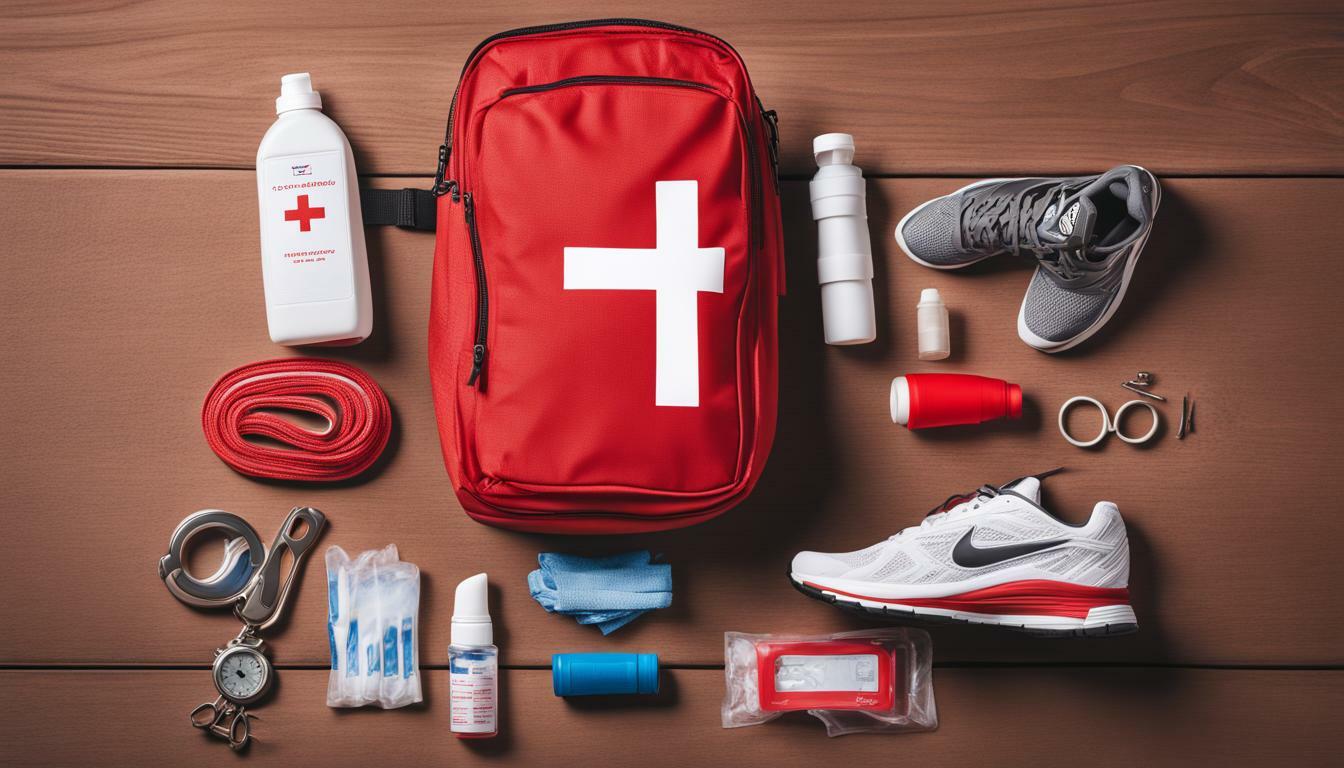Welcome to our comprehensive guide on first aid kits for marathon spectators, where we focus on the importance of caring for onlookers during a marathon event. As a spectator, it’s essential to be prepared for any potential medical emergencies that could arise. This guide provides you with valuable information on how to prepare and deal with emergency situations during a marathon event.
Marathons are exciting events, but they can also be challenging for spectators. Large crowds, varying weather conditions, and long periods of standing can lead to injuries. Therefore, it’s essential to be equipped with the right tools and knowledge to deal with any emergencies that may occur. Our onlooker first aid guide will help you gain a better understanding of how to prevent injuries and how to deal with them if they do happen.
Throughout this guide, we will provide you with marathon safety tips and essential information on what should be included in your first aid kit for marathon spectators. Furthermore, we will guide you through the key considerations for spectator safety and provide an overview of the medical services available at marathon events. With this information, you can enjoy the marathon event with peace of mind, knowing that you are well-prepared for any unexpected situations that may arise.
Stay tuned for the next section, where we will delve into the importance of marathon safety and how it relates to first aid for spectators.
Understanding Marathon Safety
Marathons are events of great excitement and energy, where crowds of people gather to show their support to the runners. However, it is important to remember that marathons can also pose potential risks and hazards to onlookers. As such, understanding marathon safety is paramount for first aid for marathon spectators.
One of the most important marathon safety tips is to stay aware of your surroundings. Large crowds can make it difficult to move around, and it’s important to pay attention to what is happening around you. Be mindful of any potential hazards, like uneven terrain or obstructions in the path.
Another important aspect of marathon safety is crowd safety. With so many people gathered in one place, it’s essential to be aware of the behavior of others around you. Keep an eye out for any suspicious activity or potential danger and alert the necessary authorities if needed. Also, be mindful of crowded areas and avoid congested areas as much as possible, as this is where accidents are more likely to happen.
First aid for marathon spectators is also an important consideration for marathon safety. Having a well-stocked first aid kit can go a long way in providing essential first aid assistance in the event of an injury. It’s important to include basic supplies such as bandages, antiseptics, and pain relievers. Also, consider including items such as sunscreen and insect repellent.
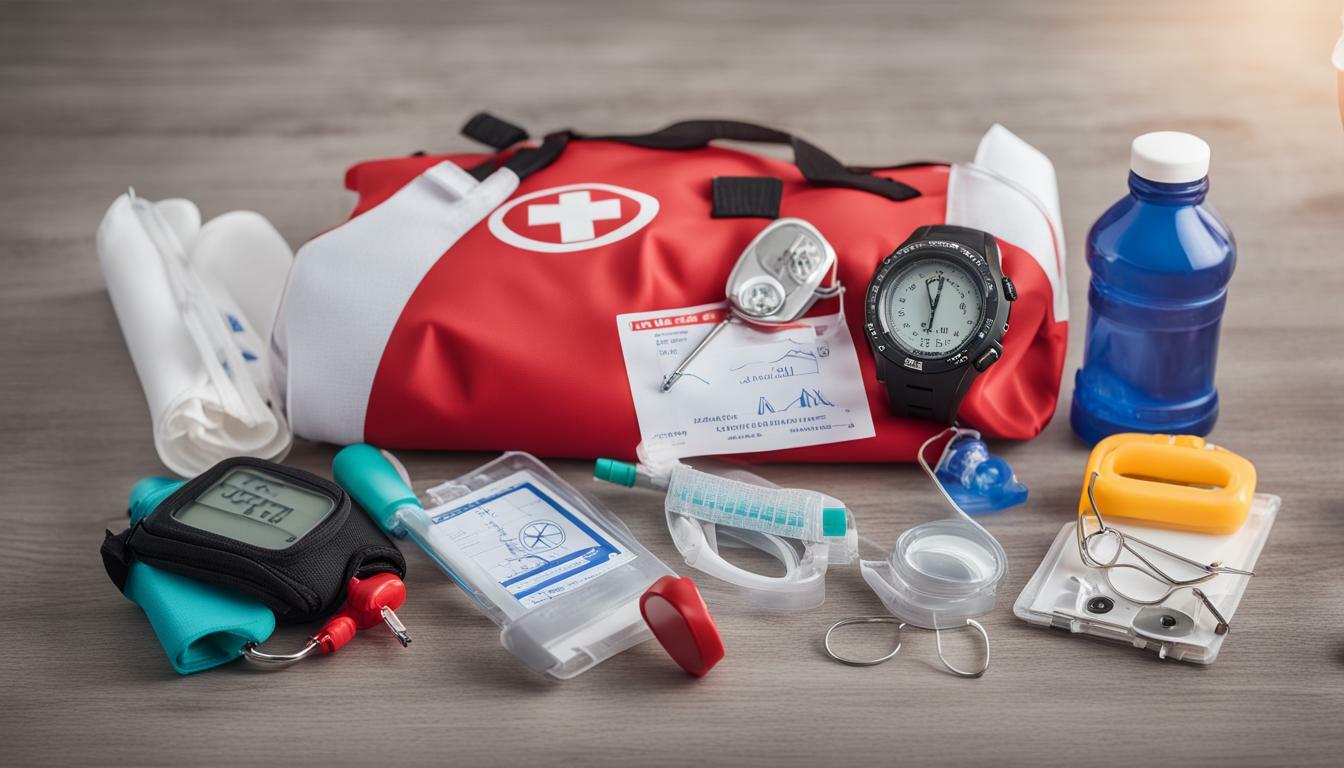
Overall, understanding marathon safety is crucial for first aid for marathon spectators. By staying aware of your surroundings, being mindful of crowd safety, and having a well-stocked first aid kit, you can help ensure the well-being of both yourself and those around you during a marathon event.
The Importance of First Aid Kits for Spectators
When attending a marathon as a spectator, it is crucial to be prepared for emergencies. This is where a first aid kit for marathon spectators comes in handy. Onlooker first aid essentials can help provide immediate medical assistance to those in need, ensuring their safety and well-being during the event.
Marathon medical assistance may not always be immediately available or accessible due to crowds or other factors. Therefore, having a well-stocked first aid kit can make all the difference in treating injuries promptly.
| Onlooker First Aid Essentials | Importance |
|---|---|
| Bandages and plasters | Can be used to dress cuts, grazes, and other minor wounds, preventing them from becoming infected. |
| Painkillers | Can help alleviate pain caused by injuries or other medical issues such as headaches or cramps. |
| Antiseptic wipes or solution | Can be used to clean wounds before dressing them, reducing the risk of infection. |
| Tweezers and scissors | Can be used to remove splinters or cut bandages to size. |
| Instant ice packs | Can provide relief for sprains, strains, and other injuries that cause swelling or inflammation. |
| Disposable gloves | Can help protect both the injured person and the first aider from cross-contamination and infection. |
| Whistle and torch | Can be used to attract attention in the event of an emergency or to navigate in low-light conditions. |
These items are just a few of the essential emergency medical supplies for spectators that should be included in a first aid kit for marathon events. However, it is important to note that the specific contents may vary depending on personal needs and the size of the kit.
Being prepared with a first aid kit for marathon spectators and onlooker first aid essentials is an easy and practical way to ensure the well-being of both yourself and those around you at marathon events.

Building Your Own First Aid Kit
When it comes to treating injuries at marathons, having a first aid kit at hand is crucial. Building your own first aid kit for marathon spectator purposes is not only cost-effective but also allows you to customize it according to your needs.
Here are some onlooker first aid essentials that should be included in your kit:
| Item | Purpose |
|---|---|
| Adhesive bandages | To cover small cuts and blisters |
| Gauze pads | To absorb blood and other fluids |
| Tweezers | To remove splinters and other debris |
| Antiseptic wipes | To clean wounds and prevent infection |
| Pain relievers | To alleviate pain from injuries |
| Instant cold pack | To reduce swelling on sprains and bruises |
Additionally, other emergency medical supplies for spectators that you may consider including are:
- Emergency whistle – to signal for help
- Gloves – to protect yourself from bodily fluids and contaminants
- Flashlight – to help see in the dark or to examine wounds more closely
- Face shield – to protect yourself when performing CPR
By having all the necessary items on hand, you will be better equipped to provide prompt first aid to yourself or those around you. Remember to regularly check and replenish your first aid kit to ensure that it’s always up-to-date and well-stocked.
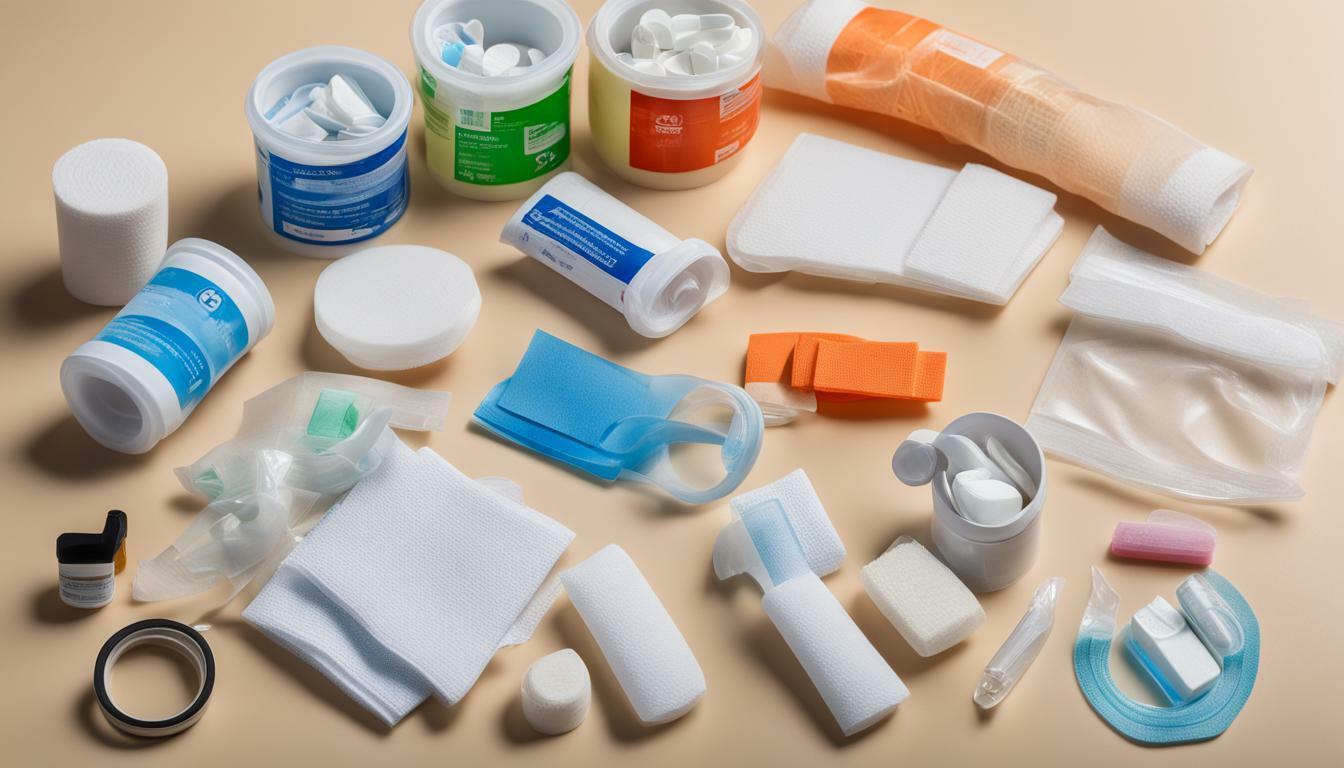
Essential First Aid Skills for Spectators
As a spectator at a marathon event, it’s important to be prepared to provide immediate medical assistance to those in need. Knowing basic first aid skills can help you handle common injuries that may occur during the event and prevent them from escalating into more serious situations. Here are some essential first aid skills every spectator should possess:
Handling Sprains and Strains
Sprains and strains are common injuries that can occur during marathons. If someone near you experiences a sprain or strain, encourage them to stop running or walking immediately. Help them find a comfortable place to sit and elevate the affected area. Apply a cold compress to the injury for 15 to 20 minutes to reduce swelling. Repeat this process every two to three hours for the first 24 to 48 hours. If the pain is severe, seek medical attention.
Treating Cuts and Abrasions
Cuts and abrasions can occur when runners accidentally bump into spectators or trip and fall. If you come across someone with a cut or abrasion, wash the wound with soap and water and apply a sterile bandage. If the bleeding does not stop or the wound looks infected, seek medical attention.
Recognising Heat Exhaustion
Marathons can be physically demanding, and it’s not uncommon for runners to suffer from heat exhaustion. Symptoms include dizziness, nausea, headaches, and loss of consciousness. If someone near you exhibits any of these symptoms, move them to a cool, shaded area and have them drink water or a sports drink. Loosen any tight clothing and apply a cool, damp cloth to their forehead, neck, and wrists. If the symptoms persist or worsen, seek medical assistance.
Providing Basic CPR
In extreme cases, a runner or spectator may experience cardiac arrest. If you witness someone collapsing and they are unresponsive, call for medical assistance immediately. In the meantime, provide basic CPR by performing chest compressions at a rate of 100 to 120 per minute. Continue until medical help arrives.
By being equipped with these essential first aid skills, you can help ensure the well-being of those around you at marathon events.
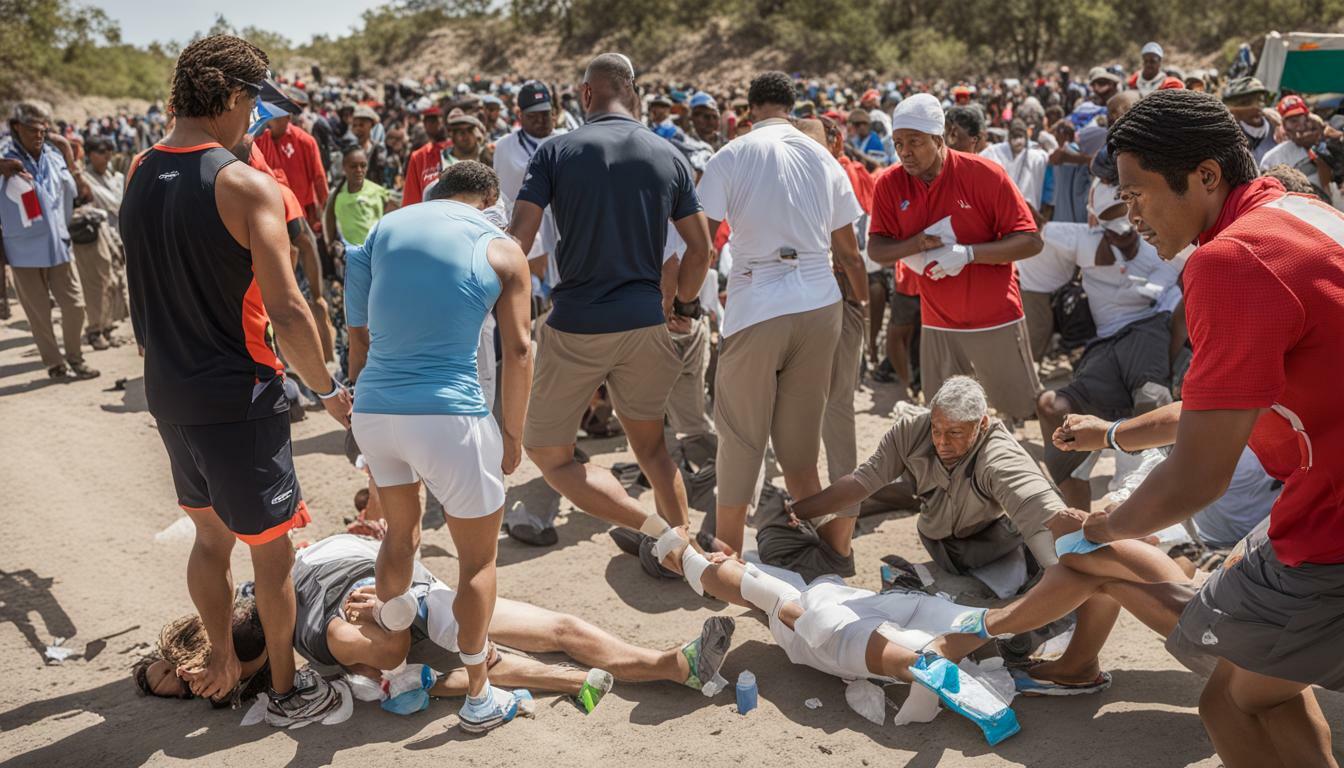
Seeking Professional Medical Help
While having a well-stocked first aid kit and basic first aid skills are essential for caring for injured spectators, there are situations where professional medical help is necessary. If an injury is severe or deemed an emergency, it is crucial to call for medical assistance immediately.
When calling for medical help, provide clear and concise information about the location, nature, and severity of the injury. Stay on the line until the operator has gathered all the necessary information and follow their instructions closely.
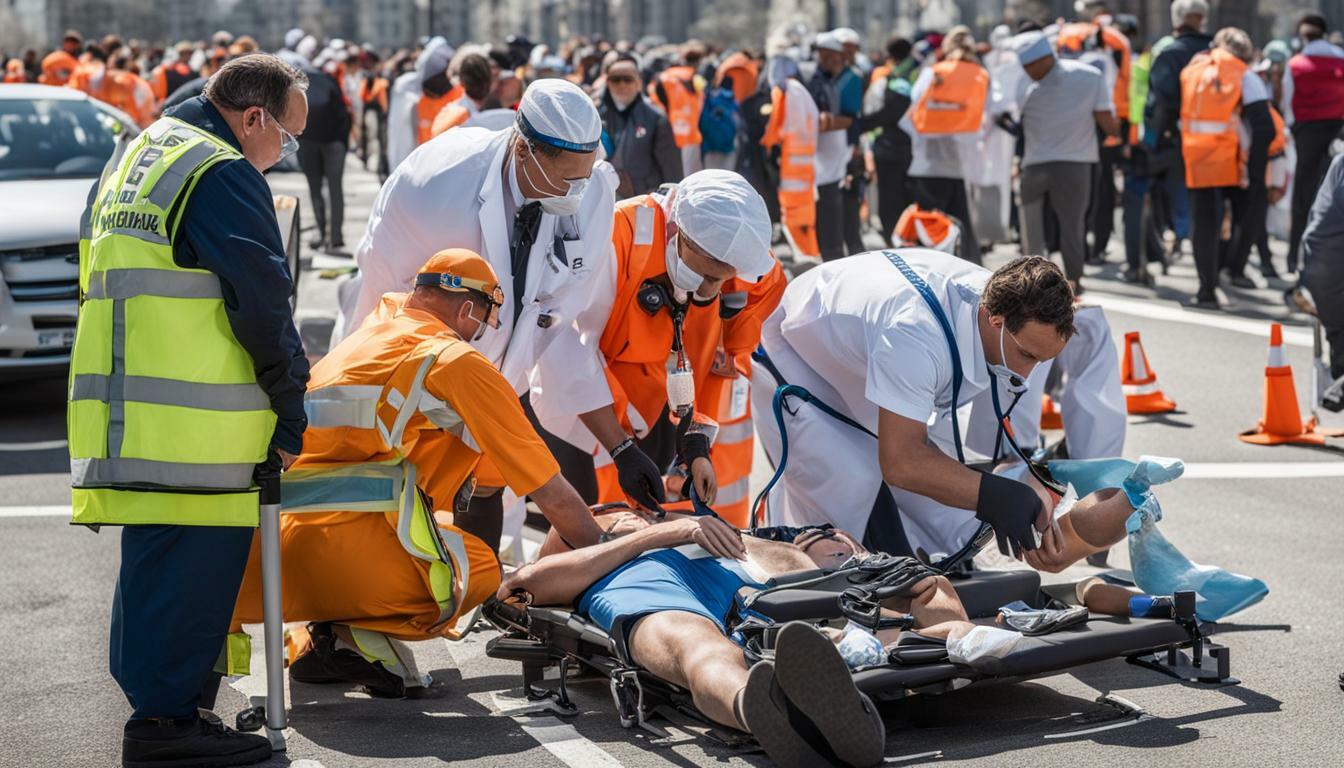
Most marathons have a medical tent or team on site to provide medical assistance for both runners and spectators. If you or someone around you requires medical attention, locate the nearest medical personnel and seek their help as soon as possible.
Remember to stay calm and act quickly when dealing with injuries at marathons. By being prepared and knowledgeable about first aid and medical assistance, you can help ensure the safety and well-being of everyone involved in the event.
Key Considerations for Spectator Safety
Ensuring your safety as a marathon spectator goes beyond first aid kits. It requires a combination of careful planning, awareness, and adherence to event guidelines.
Firstly, make sure to stay hydrated throughout the event. Bring plenty of water and sports drinks to keep you hydrated, especially on hot days.
Wearing appropriate clothing is also crucial for your safety. Dress in comfortable, loose-fitting clothes and wear comfortable shoes that allow you to move around easily.
It is also important to follow event guidelines to ensure the well-being of both you and the runners. Do not cross the racecourse, stay behind the designated spectator areas, and be mindful of your surroundings at all times.
Furthermore, if you are bringing children with you, make sure they are within your line of sight at all times and keep them close to you.
Lastly, be aware of potential hazards in the crowd, such as pushing and shoving. Stay clear of aggressive or unruly spectators and alert security if necessary.
By following these marathon safety tips and adhering to event guidelines, you can help make sure that your marathon experience is safe and enjoyable for everyone involved.

Being Prepared for Unexpected Situations
During marathon events, unexpected situations can occur, and it’s important to be prepared. In addition to having a well-stocked first aid kit for marathon spectators, there are other items you may consider adding to your emergency supplies.
One essential item is a portable phone charger. Your mobile phone may be your lifeline in an emergency, but it’s useless if the battery is dead. A portable charger can ensure that you’re able to make calls or access emergency services if needed.
Another useful item to have is a whistle. If you or someone else requires assistance, a whistle can attract the attention of nearby medical personnel or security staff. It’s a simple but effective way to signal for help in a crowded and noisy environment.
A small flashlight is also a good addition to your emergency kit. If an unexpected situation occurs after dark, a flashlight can help you navigate your way to safety and signal for assistance. Make sure to check the batteries before the event to ensure it’s working correctly.
Lastly, consider bringing a lightweight blanket or thermal wrap. This can help keep you or an injured spectator warm if the weather turns chilly or in case of shock. It’s always better to be over-prepared than under-prepared.
By including these items in your emergency kit along with the onlooker first aid essentials, you can be ready for any unexpected situation.
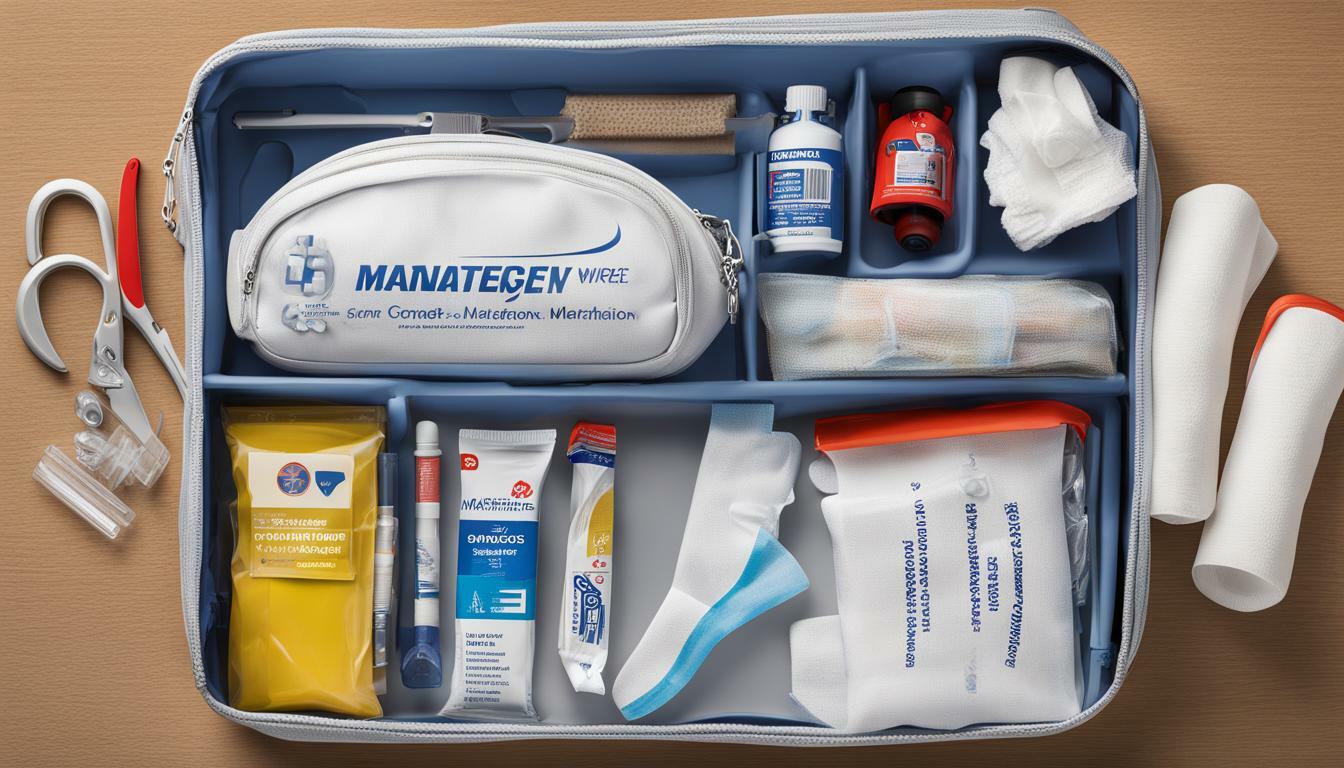
The Importance of Caring for Onlookers at Marathons
In conclusion, it’s important to remember that marathons are not just about the runners but also about the safety and well-being of the onlookers. By being prepared with a first aid kit and possessing basic first aid skills, spectators can help ensure their own safety and the safety of those around them.
It’s also crucial to understand marathon safety and the potential risks and hazards that may arise during these events. Spectators should follow event guidelines and take additional safety precautions, such as staying hydrated and wearing appropriate clothing to avoid heat exhaustion or other injuries.
Even with proper preparation and precautions, unexpected situations may arise. This is why it’s essential to have a well-stocked first aid kit and to know when to seek professional medical help. In the event of an emergency, quick and decisive action can make all the difference in ensuring a positive outcome.
Be Proactive
By being proactive and taking the necessary steps to prepare for unexpected situations, marathon spectators can help ensure a safe and enjoyable experience for everyone involved. Remember, caring for onlookers is just as important as caring for the runners themselves.
